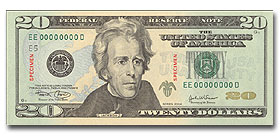NEW YORK (CNN/Money) -
The new pink $20 bill is about to enter into circulation, like it or not. But the government wants you to like it.
The Department of the Treasury will spend $53 million over the next five years on a public relations campaign to market new money (in addition to the new $20, the budget includes expenditures to promote the planned releases of a new $50 in 2004 and a new $100 in 2005). To do the job, it has signed up a few of Hollywood's leading image makers.

| |
|
A star turn for the new $20. Click on the image for a larger view.
|
|
"The goal is public education, to build awareness and trust," said Dawn Haley, a spokeswoman for the Bureau of Engraving and Printing (BEP).
On Oct. 9, the new bills will begin to circulate, as banks around the country release them to customers. Since they will be the nation's official currency, you'll have no choice but to use the notes. Even so, the BEP wants to make sure nobody is confused into questioning the authenticity of the bills, despite their radically altered look.
The government has occasionally mounted public awareness programs in the past. (Remember the drive to "go metric" in the 1970s?)
According to Haley, the BEP has spent money to market money at least since the early 1990s, when it began to explain and promote the anti-counterfeiting features of a number of newly designed notes.
This time, the effort seems a bit more sophisticated. The Bureau has worked with cash-intensive industries, such as vending machines and retailers, for over a year to prepare them for the changes.
It has sent out instructional packets to more than 7,000 businesses and organizations, designed to teach merchants how to identify authentic new bills. There is also an elaborate Web presence at www.moneyfactory.com.
What's more, the effort is a global one. "More than 60 percent of all U.S. currency is actually outside of the country," notes Haley. "We want to make sure the new bills are recognized internationally as well as at home."
The Web site and other marketing materials have been translated into 14 languages, and the Bureau has run public relations events in such far flung locales as Russia and Ecuador.
Going Hollywood
In an age of media saturation, no publicity campaign is complete without some sort of Hollywood spin. "We did a lot of research," said Haley. "The focus groups all told us that if you want broad reach, you have to be on TV."
Although the Bureau intends to do a bit of paid advertising, its total outreach budget is only about $10 million a year. For a typical big product marketer, that's practically a rounding error.
To get around the problem, BEP retained public relations giant Burston-Marsteller to build a campaign filled with somewhat cheaper alternatives to a full-throttle series of commercials. One of the most creative: product placement.
In January, BEP hired two prominent Hollywood firms, Davie-Brown and William Morris, to help get the new money featured on television shows. Earlier this month, the Wheel of Fortune spotlighted it on its "Big Money Week."
Pepsi's "Play for a Billion" game show, aired Sept. 14 on the WB Network, also showcased the new $20s. An opening sequence on the show contained a loving shot of $1 billion worth of the bills, in all their melba-tinged glory.
According to the show's co-producer, Matti Leshem, it was an easy decision to make. "We wanted a shot of a billion dollars, but it would have been pretty difficult to round up that kind of money on our own," he said. "When Davie-Brown approached us, it seemed a perfect fit."
Neither the BEP nor its retained firms would put a precise figure on the price of each placement, but it's minimal relative to production costs for television ads, or, for that matter, product placement fees for commercial products.
That may be one reason the government will aggressively use the technique to heighten the pinkback's visibility. Placements will soon appear on "Jeopardy," "America's Funniest Home Videos," "Who Wants to Be a Millionaire," and ESPN's "College Game Day."

|

